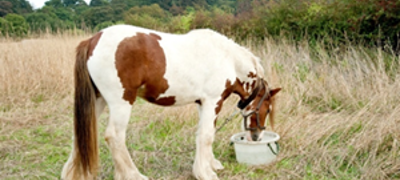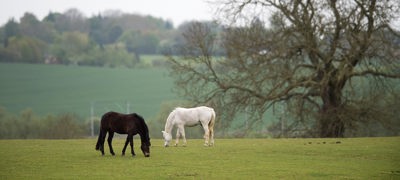When considering if your horse needs to wear a rug, it’s important not to make this decision based on how warm or cold you feel. Horses don’t feel the cold in the same way that we do, the thicker winter coat that grows over the colder months acts as a great natural insulator for your horse, to keep them warm and dry. Without putting on extra layers, humans will start to feel the cold when the temperature drops below 20°C, while your horse may still be warm and happy in their natural winter coat until the temperature drops below 5°C1. Assess each individual horse based on their needs and management to help you rug accordingly if required.
Many horses, especially native breeds and cob types, can adapt well to winter weather and easily cope without a rug when they have adequate forage and access to shelter.
Try not to overgroom un-rugged horses as this may strip the coat of the natural oils and reduce its waterproofing abilities. If your horse is wearing any tack, make sure mud is removed from the areas where the equipment is fitted to prevent rubbing and discomfort.
Reasons a horse may need a rug
- Breeds that have a naturally thinner winter coat such as a thoroughbred or Arab.
- Underweight horses to help them keep warm so they don’t use more energy, leading to further weight loss.
- Fully clipped horses will require an appropriate rug to compensate for their natural coat being removed.
- Rugging older horses or horses who are ill can be advisable, as typically they have more difficulty regulating their body heat. Older horses may also experience an arthritic flare up from the cold and damp, which reduces movement and therefore the creation of body heat.
- To protect your horse from biting insects (fly rug).
- When cooling down after intense exercise.
- When travelling during colder weather.
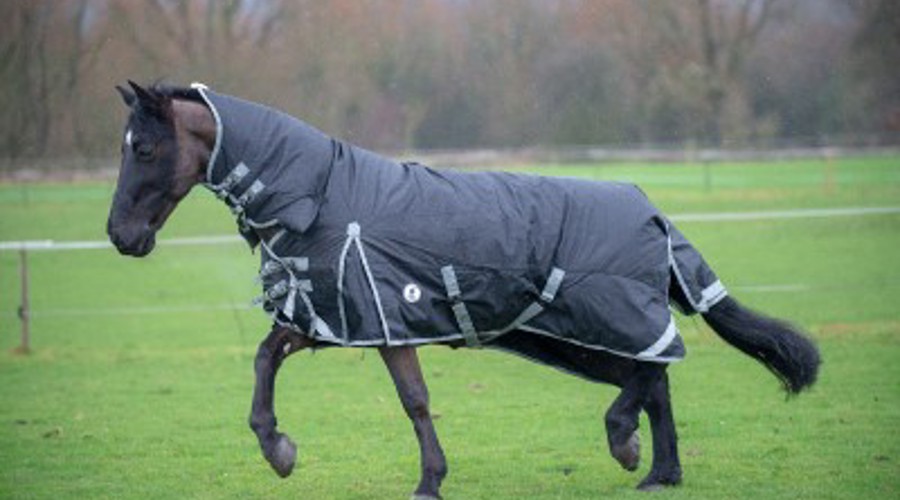
How horses naturally keep warm
When the environmental temperature drops below 5°C, the horse must produce more heat which may be done in several ways:
Self-protection
chevron-down
chevron-up
Horses will naturally turn their backs on wind and rain to protect themselves in poor weather. If in a group environment, they will also huddle closely to share their warmth.
Natural shelter
chevron-down
chevron-up
Thick hedges and tree lines make great forms of natural shelter from the wind and rain. If there isn’t any natural shelter, it’s important to provide a field shelter as an option for the horse to seek shelter (planning permission can vary between local authorities so check if any regulations are in place).
Horses are more likely to feel the cold through a combination of persistent wind and rain. In these circumstances, having a good source of shelter will provide the most protection and help them stay warm.
Natural insulation
chevron-down
chevron-up
Horses lose very little body heat through the air as their coat hairs stand on end, trapping heat and creating a layer of insulating body heat. You might have noticed horses with unmelted frost or snow on their backs. The reason this doesn’t melt is because the horse’s winter coat works by insulating them and not letting the heat escape.
Forage
chevron-down
chevron-up
Eating forage consistently throughout the day helps to keep the horse warm, acting as an in-built heating system by creating heat as the fibre is broken down in their digestive system.
Increasing metabolic rate
chevron-down
chevron-up
Horses will use more energy to keep themselves warm. This is a natural process throughout winter and allows any excess weight gained through the summer months to drop off as nature intended.
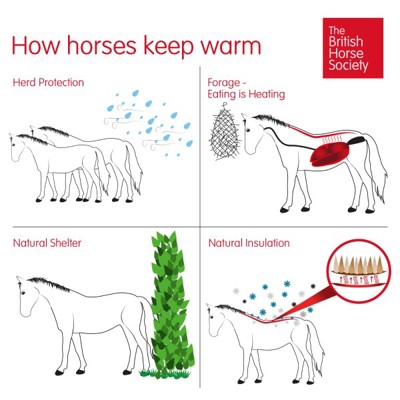
What to look out for when choosing a rug for your horse
Rug type
chevron-down
chevron-up
There are many different types of horse rug that each have their own specific uses throughout the year, not just to keep your horse warm during the winter months. Making sure to pick the right type of rug for the circumstances is essential to keeping your horse happy and comfortable.
- Turnout rug — a waterproof rug to be worn when turned out.
- Stable rug —often cotton or fleece sheet to be worn indoors.
- Exercise sheet — a small sheet that can be worn when riding to keep the horse’s hind quarters warm. Be aware that your horse will get hotter with exercise so you may only need an exercise sheet while warming up. Exercise waterproof sheets are also available to help keep your horse dry.
- Cooler rug — a thin sheet to prevent a sweaty horse getting too cold while drying off after intense exercise.
- Travel rug — if your horse is clipped or is sensitive to the cold, they may need a thin sheet when travelling. Be aware that your horse uses energy to balance when travelling so may be warmer than when they’re standing in the stable.
- Fly / sweet itch rug —– during the spring and summer months when the biting insects emerge, your horse may need a fly rug to protect them. If your horse has sweet itch, they may need a specialist rug to protect them further.
- Neck covers — some rugs have a built-in or removable neck to provide the horse with more coverage. Be aware that if your horse has a thick mane, a neck cover may cause overheating or irritation.
Denier
chevron-down
chevron-up
Just like a pair of tights, the denier relates to how strong the outer fabric of a rug is. So, the higher the denier, the stronger the material will be. A higher denier rug also provides more water resistance to keep your horse dry in wetter weather.
Fill
chevron-down
chevron-up
The fill is used to describe the rug weight and can be categorised as:
- Light weight: 0g -100g
- Medium weight: 150g - 250g
- Heavy weight: 300g plus.
What are the risks of inappropriate rugging?
Overrides natural insulation
chevron-down
chevron-up
If an inappropriate rug is used, it can override the horse’s natural process of insulation. As the hair is flattened, it is less efficient at trapping heat to insulate the horse’s body.
Vitamin deficiency
chevron-down
chevron-up
Inappropriate rugging prevents sunlight reaching the horse’s skin, limiting the production of vitamin D2. A deficiency can lead to reduced bone strength, however an hour a day exposure without a rug in bright, dry conditions, should be sufficient in minimising this risk2.
Increased stress on the horse
chevron-down
chevron-up
If a thick fill rug is used in inappropriate conditions, it will trap a lot of heat, which can radiate back to the horse’s body. As a result, the horse will be continuously trying to cool down which can place a lot of stress on the horse, causing them to sweat and making them uncomfortable. It’s much easier for a horse to warm themselves up than it is to cool themselves down.
Preventing natural weight loss
chevron-down
chevron-up
Horses naturally lose weight during the winter months, but we can override this process by feeding them too much and over-rugging. This can result in the horse putting on excess weight all year round, which is worrying as weight gain increases the risk of laminitis. Not rugging an overweight horse will help them lose weight naturally.
Don’t keep an overweight horse unnecessarily rugged through winter as this time of year can be used as an advantage to help the horse lose weight. Instead of unused calories being laid down as excess fat, the horse can use the calories to keep warm. Horses with a bib or trace clip often cope well without having to wear a rug, especially if they’re overweight.
Impact on body temperature
chevron-down
chevron-up
- A 0g rain sheet can be a great choice in light rain, however, be conscious that in very poor weather, the rain is likely to seep through. When this happens, cold air meets heat from the horse’s body forming condensation under the rain sheet. As the lower temperature reaches the horse’s skin, their body temperature can reduce.
- If your horse is very sweaty after exercise, a thin cooler rug made from a wicking material, such as wool or polar fleece, can help your horse dry faster while keeping them warm, to help prevent them getting chilled3. Once the horse is dry, any dried sweat can be brushed off and an appropriate rug put on if required.
How to rug a horse
If rugging your horse, it’s vital that the rug fits correctly to limit any chance of rubbing or soreness. If your horse wears a rug it’s important to remove it daily so you can check for signs of rubbing or soreness and then refit or change as necessary. An ill-fitting rug or one left on for too long without checking might cause discomfort or even start to rub and cause injury as shown in the image below.

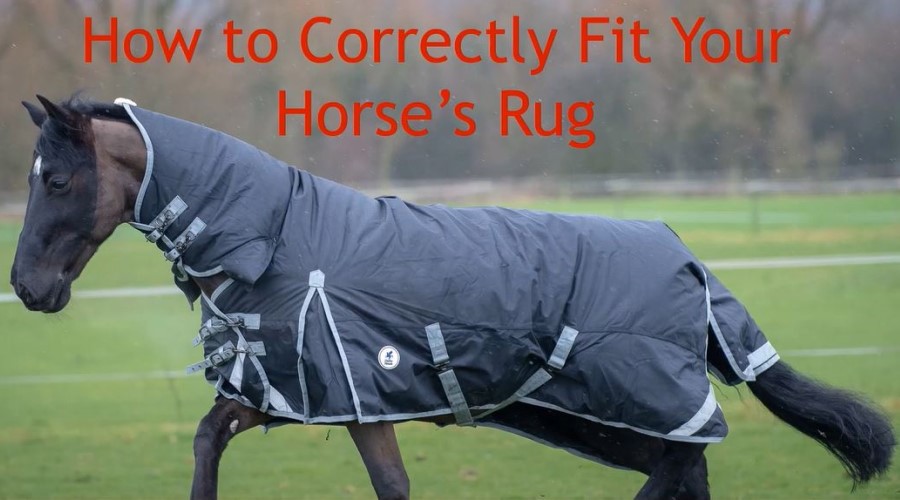 play-circle
play-circle
Watch
How to correctly fit your horse's rug
References
chevron-down
chevron-up
- Mejdell, C.M. et al (2020) Caring for the horse in a cold climate—Reviewing principles for thermoregulation and horse preferences. Applied Animal Behaviour Science. Vol 231.
- Azarpeykan, S., et al. (2016): "Influence of blanketing and season on vitamin D and parathyroid hormone, calcium, phosphorus, and magnesium concentrations in horses in New Zealand." Domestic animal endocrinology 56 75-84.
- Cooling Your Horse Out on Cold Days – The Horse
Get in touch – we’re here to help
The BHS Horse Care and Welfare Team are available to offer you advice and support with any questions or concerns you may have.
Don’t hesitate to call us on 02476 840517* or email welfare@bhs.org.uk – You can also get in touch with us via our social media channels.
Opening times are 8:35am - 5pm from Monday – Thursday and 8:35am - 3pm on Friday.
*Calls may be recorded for monitoring purposes.





